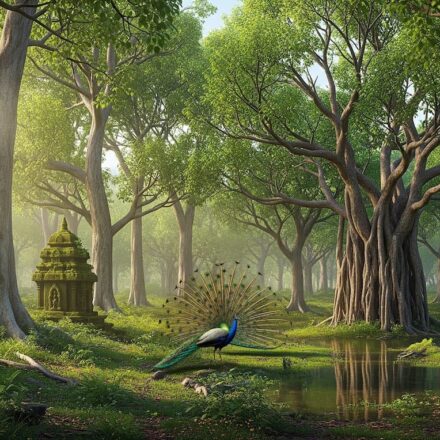
Dharma of the Forest: How Hindu Wisdom Protects a Billion Trees
We are losing our forests at an alarming rate. Modern environmentalism often frames this crisis in terms of carbon sinks, biodiversity loss, and resource management. While these perspectives are critical, they can feel distant and technical. They address the what but often miss the why—the deep, spiritual disconnection from nature that allows such destruction to happen in the first place.
What if there was a worldview where protecting a forest was not just an environmental policy, but a sacred duty? Ancient Indic wisdom offers exactly that. It presents a powerful framework where the forest is seen as a living, divine entity, and its protection is a core part of Dharma—the cosmic and moral order that sustains the universe. This isn’t just a philosophy; it’s a practical blueprint that has protected vast ecosystems for millennia.
The Forest as a Living, Sacred Being
In the Vedic worldview, nature is not an inert resource to be exploited, but a living system infused with divinity. The scriptures are filled with hymns that deify natural elements, viewing them as expressions of a single, underlying consciousness. This is rooted in the concept of Prakriti, the primordial, creative energy from which the entire material universe unfolds. The world we see—including every tree, river, and mountain—is a manifestation of this divine feminine principle.
This perspective teaches that the five great elements, or Pancha Mahabhutas (Earth, Water, Fire, Air, and Space), are the sacred building blocks of all life, including our own bodies. Therefore, to harm the forest is to desecrate a sacred entity and, by extension, to harm a part of ourselves. This profound sense of interconnectedness is the foundation of Hindu ecological ethics.
Dharma: The Righteous Duty to Protect
The concept of Dharma, derived from the Sanskrit root “dhr” (to uphold or sustain), is central to Indic philosophy. It is the universal law that maintains cosmic order and balance. Every being has a dharma, a role to play in the harmonious functioning of the universe. From this standpoint, protecting nature is not merely a suggestion but a fundamental moral and spiritual duty.
The ancient texts teach that when humanity lives in accordance with Dharma, the natural world flourishes. Conversely, when Dharma declines, human greed leads to the despoiling of nature, causing imbalance and chaos. Therefore, the “Dharma of the Forest” is our sacred obligation to act as its custodians, ensuring its health and vitality for the well-being of all. This is a core part of whatHindu teachings ground environmental conservation in spiritual tradition.
Sacred Groves: Dharma in Action
This philosophy was not just abstract; it was put into practice through sophisticated systems of community-based conservation, now recognized as Traditional Ecological Knowledge (TEK). The most powerful example is the tradition of the sacred grove, known as
Tapovana. These were patches of virgin forest dedicated to a deity and left untouched by the local population.
These groves were protected by a powerful combination of reverence and social taboo. It was believed that the resident deity would punish anyone who dared to cut a tree or harm the grove. As a result, these sacred groves became vital reservoirs of biodiversity, containing rare and endangered species and serving as a genetic bank for the surrounding areas. They are a living testament to how a spiritual worldview can create one of the most effective forms of environmental protection.
Ahimsa: Extending Non-Violence to All of Nature
The principle of Ahimsa, or non-violence, is a cornerstone of Hindu ethics. It is a call to cause no harm in thought, word, or deed to any living being. This ethic of compassion is not limited to humans and animals; it extends to the entire plant kingdom. The scriptures are clear that trees are living beings, and their unnecessary destruction is a violent act.
The Rig Veda explicitly states, “Do not cut trees because they remove pollution”. This ancient understanding of the vital role forests play in maintaining ecological balance is a powerful call to action. Practicing Ahimsa requires us to live in a way that minimizes our harm to the environment, making conscious choices that honor the sanctity of all life.
Conclusion: Reawakening Our Sacred Duty
The Dharma of the Forest is a holistic vision that integrates the spiritual with the practical. It teaches us that our environmental crisis is a reflection of a deeper spiritual crisis—a loss of reverence for the sacredness of life. By viewing the forest as a divine entity, recognizing our sacred duty to protect it, and practicing non-violence towards all of nature, we can reawaken a powerful and effective model for conservation. This ancient wisdom is not a relic of the past; it is a living, breathing guide that can help us protect our planet for generations to come.
If this article inspired you, please share it with someone who would benefit from its message. A single share can help spread this timeless wisdom. For more content that bridges ancient knowledge with modern life, follow us on our social media channels and continue your journey at aninspiredsoul.com










